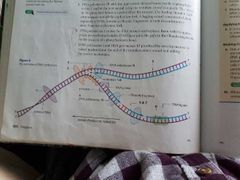![]()
![]()
![]()
Use LEFT and RIGHT arrow keys to navigate between flashcards;
Use UP and DOWN arrow keys to flip the card;
H to show hint;
A reads text to speech;
11 Cards in this Set
- Front
- Back
|
Replication Fork |
The process if unwinding one dna to make two DNA from it
|
|
|
dna replication steps |

there are 'seven' pg 222 |
|
|
1 |
The enzyme gyrase relieves any tension from the unwinding of the double helix |
|
|
2 |
dna helicase breaks the hydrogen binds holding the two complementary original strands together, resulting in an unwound helix that ends at the fork (the split)
|
|
|
3 |
Single - stranded binding proteins anneal (google the bio definition) the newly exposed template strand preventing them from reannealing (reannealing the two strands that recombine to form a double stranded molecule)
(aka the dna is separated into two single stands in a y shape) |
|
|
4 |
The enzyme primase lays down RNA primer, used by DNA polymerase 3 as a starting point to build the new complementary strands (building a new strand, makes the two single strands double stranded) |
|
|
5 |
DNA polymerase 3 adds the appropriate dioxyriobose triphosphates to the 3' end if the new strand using the template strand as a guide Energy in the phosphate bonds is used to drive the process. |
|
|
5 continued |
The leading strand is built continually toward the replication fork. The lagging strand is composed of short segments of DNA with small gaps in it (known as okazaki fragments) is discontinuously built away from the replication fork |
|
|
6 (lagging only |
DNA polymerase 1 excises the RNA primers and replaces them with the appropriate deoxyribonucleotides. |
|
|
6 cont (lagging only |
DNA ligase joins the gaps in the Okzaki fragments by the creation of phosphodiester bonds |
|
|
7 lagging only |
DNA polymerase 1 and DNA polymerase 3 proofread by exising incorrectly paired nucleotides at the end of the complementary strand and adding correct nucleotides |

